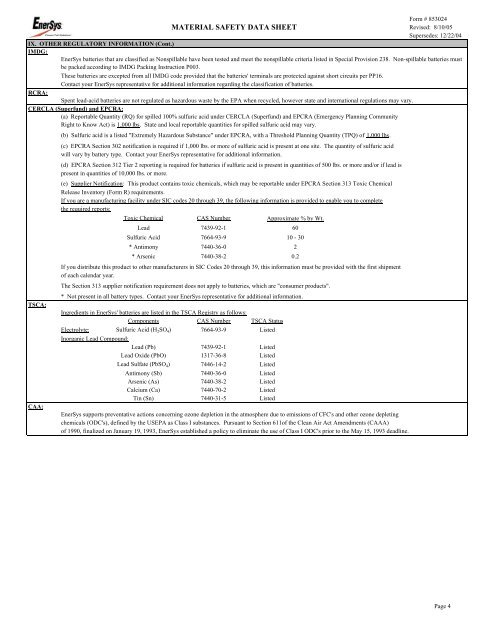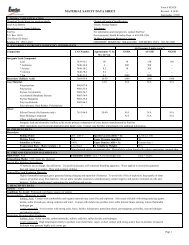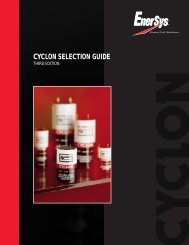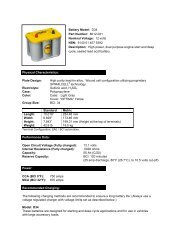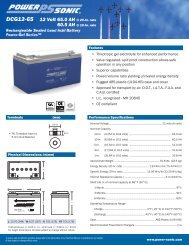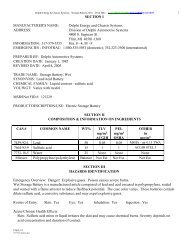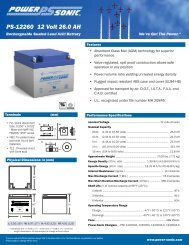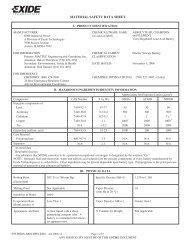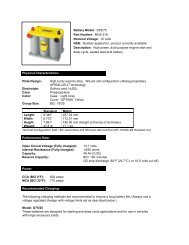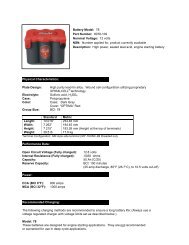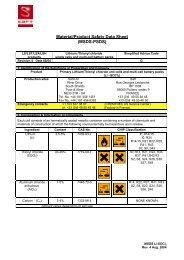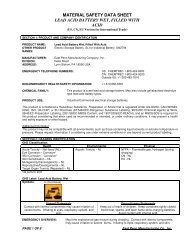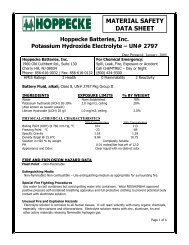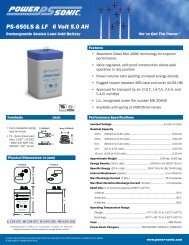Yuasa Battery MSDS - Falcon Electric
Yuasa Battery MSDS - Falcon Electric
Yuasa Battery MSDS - Falcon Electric
Create successful ePaper yourself
Turn your PDF publications into a flip-book with our unique Google optimized e-Paper software.
Form # 853024<br />
MATERIAL SAFETY DATA SHEET<br />
Revised: 8/10/05<br />
Supersedes: 12/22/04<br />
IX. OTHER REGULATORY INFORMATION (Cont.)<br />
IMDG:<br />
EnerSys batteries that are classified as Nonspillable have been tested and meet the nonspillable criteria listed in Special Provision 238. Non-spillable batteries must<br />
be packed according to IMDG Packing Instruction P003.<br />
These batteries are excepted from all IMDG code provided that the batteries' terminals are protected against short circuits per PP16.<br />
Contact your EnerSys representative for additional information regarding the classification of batteries.<br />
RCRA:<br />
Spent lead-acid batteries are not regulated as hazardous waste by the EPA when recycled, however state and international regulations may vary.<br />
CERCLA (Superfund) and EPCRA:<br />
(a) Reportable Quantity (RQ) for spilled 100% sulfuric acid under CERCLA (Superfund) and EPCRA (Emergency Planning Community<br />
Right to Know Act) is 1,000 lbs. State and local reportable quantities for spilled sulfuric acid may vary.<br />
(b) Sulfuric acid is a listed "Extremely Hazardous Substance" under EPCRA, with a Threshold Planning Quantity (TPQ) of 1,000 lbs.<br />
(c) EPCRA Section 302 notification is required if 1,000 lbs. or more of sulfuric acid is present at one site. The quantity of sulfuric acid<br />
will vary by battery type. Contact your EnerSys representative for additional information.<br />
(d) EPCRA Section 312 Tier 2 reporting is required for batteries if sulfuric acid is present in quantities of 500 lbs. or more and/or if lead is<br />
present in quantities of 10,000 lbs. or more.<br />
(e) Supplier Notification: This product contains toxic chemicals, which may be reportable under EPCRA Section 313 Toxic Chemical<br />
Release Inventory (Form R) requirements.<br />
If you are a manufacturing facility under SIC codes 20 through 39, the following information is provided to enable you to complete<br />
the required reports:<br />
TSCA:<br />
CAA:<br />
Toxic Chemical<br />
CAS Number<br />
Lead 7439-92-1<br />
60<br />
Sulfuric Acid 7664-93-9<br />
10 - 30<br />
* Antimony 7440-36-0<br />
2<br />
* Arsenic 7440-38-2<br />
0.2<br />
If you distribute this product to other manufacturers in SIC Codes 20 through 39, this information must be provided with the first shipment<br />
of each calendar year.<br />
The Section 313 supplier notification requirement does not apply to batteries, which are "consumer products".<br />
* Not present in all battery types. Contact your EnerSys representative for additional information.<br />
Ingredients in EnerSys' batteries are listed in the TSCA Registry as follows:<br />
Components CAS Number TSCA Status<br />
Electrolyte: Sulfuric Acid (H 2 SO 4 ) 7664-93-9 Listed<br />
Inorganic Lead Compound:<br />
Lead (Pb) 7439-92-1 Listed<br />
Lead Oxide (PbO) 1317-36-8 Listed<br />
Lead Sulfate (PbSO 4 ) 7446-14-2 Listed<br />
Antimony (Sb) 7440-36-0 Listed<br />
Arsenic (As) 7440-38-2 Listed<br />
Calcium (Ca) 7440-70-2 Listed<br />
Tin (Sn) 7440-31-5 Listed<br />
Approximate % by Wt.<br />
EnerSys supports preventative actions concerning ozone depletion in the atmosphere due to emissions of CFC's and other ozone depleting<br />
chemicals (ODC's), defined by the USEPA as Class I substances. Pursuant to Section 611of the Clean Air Act Amendments (CAAA)<br />
of 1990, finalized on January 19, 1993, EnerSys established a policy to eliminate the use of Class I ODC's prior to the May 15, 1993 deadline.<br />
Page 4


